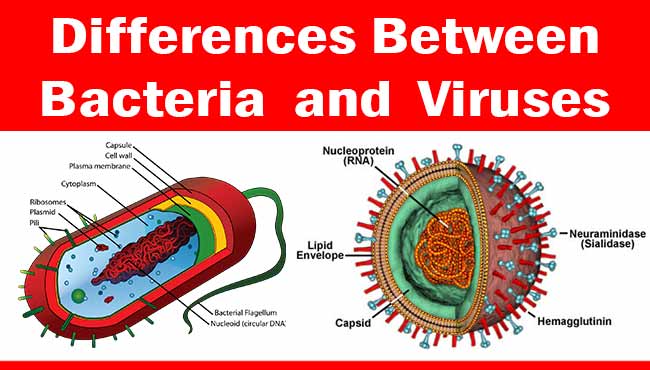Although bacteria and viruses both are very small to be seen without a microscope, there are many differences between Bacteria and Viruses.
Some of the Differences Between Bacteria and Viruses are as follows:
| S.N. | Characteristics | Bacteria | Viruses |
|---|---|---|---|
| 1 | Size | Larger (1000 nm) | Smaller (20-400 nm) |
| 2 | Cell Wall | Peptidoglycan or Lipopolysaccharide | No cell wall. Protein coat present instead. |
| 3 | Ribosomes | Present | Absent |
| 4 | Number of cells | One cell (Unicellular) | No cells |
| 5 | Living/Non-Living | Living organisms | Between living and non-living things. |
| 6 | DNA and RNA | DNA and RNA floating freely in cytoplasm. | DNA or RNA enclosed inside a coat of protein. |
| 7 | Infection | Localized | Systemic |
| 8 | Reproduce | Able to reproduce by itself | Need a living cell to reproduce |
| 9 | Reproduction | Fission- a form of asexual reproduction | Invades a host cell and takes over the cell causing it to make copies of the viral DNA/RNA. Destroys the host cell releasing new viruses. |
| 10 | Duration of illness | A bacterial illness commonly will last longer than 10 days. | Most viral illnesses last 2 to 10 days. |
| 11 | Fever | A bacterial illness notoriously causes a fever. | A viral infection may or may not cause a fever. |
| 12 | Cellular Machinery | Possesses a cellular machinery | Lack cellular machinery |
| 13 | Under Microscope | Visible under Light Microscope. | Visible only under Electron Microscope. |
| 14 | Benefits | Some bacteria are beneficial (Normal Flora) | Viruses are not beneficial. However, a particular virus may be able to destroy brain tumors. Viruses can be useful in genetic engineering. |
| 15 | Treatment | Antibiotics | Virus does not respond to antibiotics. |
| 16 | Examples | Staphylococcus aureus, Vibrio cholerae, etc | HIV, Hepatitis A virus, Rhino Virus, etc |
| 17 | Diseases/Infections | Food poisoning, gastritis and ulcers, meningitis, pneumonia, etc | AIDS, common cold, influenza, chickenpox, etc |


does the size of bacteria affect how powerful or strong it is
Not necessarily, for example, viruses sizes are nanometers, which is a billionth of a meter and they still cause lots of damage to us
if bacteria and viruses are so different ,why do most diseases caused by different micro- organism’s have the same signs and symptoms
its not really the same(maybe we look at long term affects) ,also signs and symptoms not the standard thing that we use to find the difference between them
Can virus and bacteria infection have thesame signs and symptoms but defferent cases?
Yes bacterial infections and virus can have the same symptoms but under different cases
If they do not require a cell to exist would it not be true they can exist on surfaces for an extended period of time in crystalline form?
Different viruses have different viabilities (‘life’ spans, or times during which they can infect a host). The viability of a virus depends on the porosity of the surface. On clothing, cloth, textured products, and paper (more porous surfaces), a virus may live only hours or a couple of days. On smooth surfaces like marble, tile, stainless steel, a toilet seat, your kitchen tabl… the virus may last days or even up to 3 weeks. Cleaning those surfaces with soap and water will kill most viruses; adding bleach or hydrogen peroxide ensures the demise of virtually all viruses by breaking the protein shell and destroying the RNA or DNA chain.
Yes they can not leave for a longer time in the surface just for few number of hours then they die
More about symptoms–chills and clamminess for instance. (trying to tell what I have and how long before I should take antibiotics.
Also breathing ?
Can virus be visible under inverted microscope
if there is no cell in viruse how does it possible to exis without cell
No 12 answers that. Viruses do not possess cellular machineries. They live in protein coats. Simply put, they do not require cells to exist.
They depend on the host cell for their survival , and remember they are between living and non living . When they are outside the host cell can still survive as crystalline .
virus is inert outside the host it’s just like chemical in the test tube. most of the time virus depend on host energy, and machinery.
yes they dont have a cellular machinery but they uses the cellular machinery (for replication and translation) of the host like their ribosomes ,even DNA polymerase and so do they survive